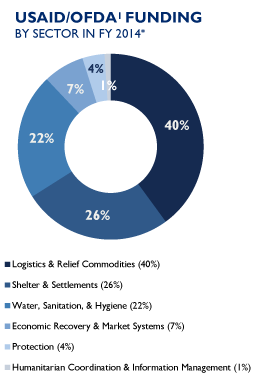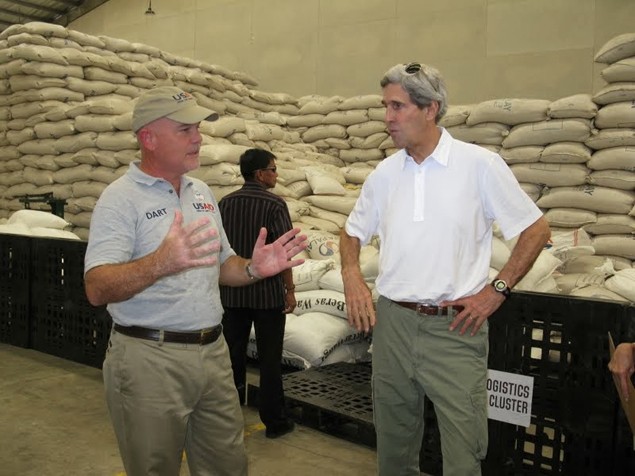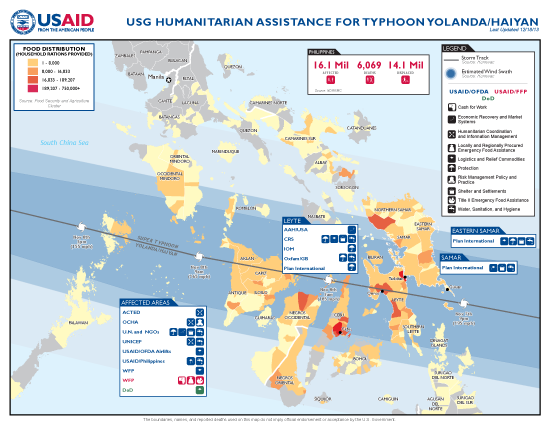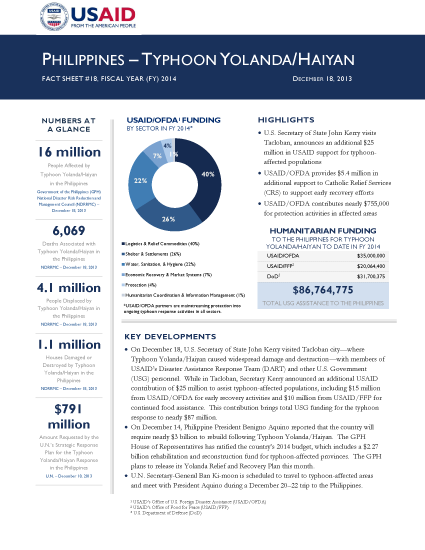- What We Do
- Agriculture and Food Security
- Democracy, Human Rights and Governance
- Economic Growth and Trade
- Education
- Ending Extreme Poverty
- Environment and Global Climate Change
- Gender Equality and Women's Empowerment
- Global Health
- Water and Sanitation
- Working in Crises and Conflict
- Disaster Assistance
- Political Transition Initiatives
- Conflict Mitigation and Prevention
- Countering Violent Extremism
- Disaster Risk Reduction
- Peacebuilding and Reconciliation
- Providing Safe & Secure Environments for Development
- Recovering From Crisis
- Resilience
- Tech Challenge for Atrocity Prevention
- World Humanitarian Day
- U.S. Global Development Lab
December 18, 2013
Numbers At A Glance
16 million
6,069
4.1 million
1.1 million
$791 million
Humanitarian Funding:
To The Philippines For Typhoon Haiyan/Yolanda To Date In FY2014:

| USAID/OFDA | $20,000,000 |
| USAID/FFP | $10,064,400 |
| DoD | $31,700,375 |
| TOTAL | $61,764,775 |
Typhoon Haiyan / Yolanda Fact Sheet #18 - 12/18/2013 ![]() (pdf - 228k)
(pdf - 228k)
Highlights
U.S. Secretary of State John Kerry visits Tacloban, announces an additional $25 million in USAID support for typhoon-affected populations.
USAID/OFDA provides $5.4 million in additional support to Catholic Relief Services (CRS) to support early recovery efforts.
USAID/OFDA contributes nearly $755,000 for protection activities in affected areas
Key Developments
On December 18, U.S. Secretary of State John Kerry visited Tacloban city—where Typhoon Yolanda/Haiyan caused widespread damage and destruction—with members of USAID’s Disaster Assistance Response Team (DART) and other U.S. Government (USG) personnel. While in Tacloban, Secretary Kerry announced an additional USAID contribution of $25 million to assist typhoon-affected populations, including $15 million from USAID/OFDA for early recovery activities and $10 million from USAID/FFP for continued food assistance. This contribution brings total USG funding for the typhoon response to nearly $87 million.
On December 14, Philippine President Benigno Aquino reported that the country will require nearly $3 billion to rebuild following Typhoon Yolanda/Haiyan. The GPH House of Representatives has ratified the country’s 2014 budget, which includes a $2.27 billion rehabilitation and reconstruction fund for typhoon-affected provinces. The GPH plans to release its Yolanda Relief and Recovery Plan this month.
U.N. Secretary-General Ban Ki-moon is scheduled to travel to typhoon-affected areas and meet with President Aquino during a December 20–22 trip to the Philippines.
AGRICULTURE AND FOOD SECURITY
- Typhoon Yolanda/Haiyan damaged more than 63,200 hectares of rice crops in Eastern Visayas Region, according to the Food Security and Agriculture Cluster, the coordinating body for humanitarian food security and agriculture activities in the Philippines. The U.N. Food and Agriculture Organization (FAO) and partners are providing rice seed to cover nearly 54,900 hectares, and FAO has sufficient resources to cover the rice seed gap of approximately 8,300 hectares for the upcoming February/March planting season. The U.N. Office for the Coordination of Humanitarian Affairs (OCHA) reports that an estimated 35,000 farmers will receive seeds for December and January planting in Western and Eastern Visayas regions.
- On December 11, the U.N. World Food Program (WFP) and the GPH Department of Social Welfare and Development (DSWD) signed a memorandum of understanding for a $6 million cash transfer program for 500,000 typhoon-affected people in Leyte, Panay, and Samar islands over the next two months. Through the program, each household will receive approximately $29 per month to meet household food needs, as well as a one-month supply of rice from WFP.
- As of December 10, WFP had dispatched 6,390 metric tons (MT) of rice, 237 MT of high-energy biscuits, and more than 8 MT of specialized nutrition products for vulnerable children, mothers, and the elderly.
- On December 18, USAID/FFP announced an additional contribution of $10 million in food assistance for typhoon-affected populations. This new assistance includes 5,000 MT of rice, sufficient to help feed 500,000 people for one month; funding for the regional procurement of additional food aid; and support for cash-for-work activities designed to promote early recovery and the rebuilding of livelihoods. To date, USAID/FFP has provided more than $20 million to WFP for the provision of food assistance to typhoon-affected populations in the Philippines.
HEALTH AND WASH
- Disease surveillance reports indicate that the most common reasons for health consultations include acute respiratory infections, fever, diarrhea, high blood pressure, skin diseases, and wounds related to both typhoon trauma and debris clearing, according to OCHA.
- As of December 11, the GPH—with support from the U.N. World Health Organization, the U.N. Children’s Fund (UNICEF), and other partners—had vaccinated approximately 36,000 children against measles and polio and provided vitamin A supplements to more than 24,500 children through a mass vaccination campaign. As families continue to return to home communities, the GPH Department of Health (DoH) is beginning to focus its resources on restoring routine immunizations within affected communities. UNICEF has provided generators, refrigerators, vaccine carriers, and other cold-chain equipment to facilitate vaccinations in Capiz, Cebu, Eastern Samar, and Leyte provinces.
- Health Cluster partners are establishing an emergency maternal care unit in Palo municipality—located adjacent to Tacloban city in Leyte Province—to provide emergency obstetrics services for approximately 8,900 expected births over the next three months.
- Water systems in affected areas continue to regain functionality. In Dagami municipality, Leyte Province, the water system has been restored, while 24 water service providers are supplying safe drinking water to an estimated 600,000 people across 21 typhoon-affected municipalities, OCHA reports. To date, Water, Sanitation, and Hygiene (WASH) Cluster partners have distributed more than 100,000 hygiene kits and reached approximately 45,000 people with hygiene promotion activities.
- USAID/OFDA recently provided nearly $1.7 million to CRS for additional WASH activities in most-affected Tacloban city. USAID/OFDA-supported activities include construction or repair of drainage systems, repair or installation of municipal water systems for rain and surface water, improvement of solid waste management, hygiene promotion interventions, and cash-for-work activities to remove debris from common land, access routes, viable household land, and storm drains to improve environmental conditions. To date, USAID/OFDA has provided more than $5.7 million for WASH activities in Eastern Samar, Leyte, and Samar provinces.

NUTRITION
- Nutrition Cluster partners have screened more than 38,000 children under the age of five for malnutrition, detecting 172 cases of severe acute malnutrition and 671 cases of moderate acute malnutrition, according to UNICEF. Humanitarian organizations are providing nutrition assistance to children identified as suffering from acute malnutrition through treatment programs.
- To date, blanket supplementary feeding has reached more than 2,400 children under five years of age in Western Visayas Region. In addition, Nutrition Cluster partners have dispatched ready-to-use supplementary foods and high-energy biscuits to Eastern Visayas Region for nearly 18,000 children under five years of age.
- Nutrition Cluster priorities currently include protection and promotion of appropriate infant and young child feeding for 250,000 pregnant women and caregivers, supplemental feeding for 145,000 children, micronutrient supplementation for 100,000 children, and treatment of acute malnutrition for 27,000 children.
PROTECTION
- Female police officers with the women and children protection desks located at police stations and DSWD staff from 20 municipalities and three cities in Eastern Samar, Leyte, and Samar provinces have identified approximately 70 cases of separated children through UNICEF’s Rapid Family Tracing and Reunification (RapidFTR) technology.
- USAID/OFDA has provided $500,000 to the International Organization for Migration (IOM) to conduct protection activities in Tacloban city. With USAID/OFDA support, IOM will build the capacity of local actors to identify and address protection issues, including gender-based violence, and provide technical support to integrate protection issues into other humanitarian assistance activities. In addition, IOM will continue to track displacement and mobility and make basic improvements at displacement sites to enhance overall protection mechanisms and measures, such as constructing partition walls and providing sanitation materials for women.
- USAID/OFDA also recently provided more than $188,000 to Oxfam/Great Britain (Oxfam/GB) to mainstream protection and gender considerations into WASH activities for typhoon-affected populations in Leyte Province. With USAID/OFDA support, Oxfam/GB, in coordination with the DoH and UNICEF, will provide direct support to the WASH Cluster to help ensure that protection mechanisms and protocols are in place during the planning, implementation, monitoring, and evaluation of WASH programs in typhoon-affected areas, with a focus on improving the coordination of protection activities between WASH Cluster members.
- As part of its recent $5.4 million contribution to CRS, USAID/OFDA provided more than $66,000 to support protection activities in Tacloban city. CRS, with USAID/OFDA support, will help affected populations replace critical documents; provide training on gender-based violence, trafficking, and child protection and corresponding referral services; and educate government officials and others on housing, land, and property rights issues.
SHELTER AND SETTLEMENTS
- Many typhoon-affected families have started to repair and rebuild their damaged or destroyed homes and require building materials, particularly tools and corrugated galvanized iron sheeting, according to OCHA. Shelter Cluster partners report difficulty obtaining the type and quantity of iron sheeting required in affected areas.
- To date, Shelter Cluster partners have provided basic emergency shelter materials, such as plastic sheeting, tents, tools, and rope, to approximately 151,000 households across affected areas. In addition, nearly 38,000 households have received support for self-recovery efforts through shelter repair kits, cash transfers, and construction materials.
- USAID/OFDA recently provided nearly $3.7 million to CRS to support early recovery shelter activities in Tacloban city. Through the program, CRS plans to provide emergency or transitional shelters to approximately 3,000 families. CRS will incorporate disaster risk reduction principals in shelter activities, with shelter structures designed to mitigate the impacts of future disasters, and help communities to understand their risks, hazards, and vulnerabilities. To date, USAID/OFDA has provided nearly $4.8 million to CRS to address shelter needs in Leyte Province.
INTERNATIONAL ASSISTANCE
- On December 16, the Asian Development Bank (ADB) approved a $372.1 million emergency assistance loan to the Philippines to help restore basic social services and rebuild communities affected by Typhoon Yolanda/Haiyan. On the same day, ADB approved a $20 million grant package from the Japan Fund for Poverty Reduction, which will support early recovery activities in 74 rural typhoon-affected municipalities. In addition to the loan and grant, ADB has already provided a $3 million grant from its Asia–Pacific Disaster Response Fund and a $500 million emergency loan to cover immediate post-disaster costs.
- On December 17, the European Commission contributed nearly $28 million in additional assistance for the typhoon response, bringing total assistance to date to $55 million, including approximately $41 million in humanitarian aid and nearly $14 million for early recovery and reconstruction.
- As of December 16, international donors had pledged more than $511 million to address the needs of populations affected by Typhoon Yolanda/Haiyan. The total amount pledged represents nearly 65 percent of the $791 million requested by the U.N.’s Typhoon Haiyan Strategic Response Plan for the Philippines.









Comment
Make a general inquiry or suggest an improvement.